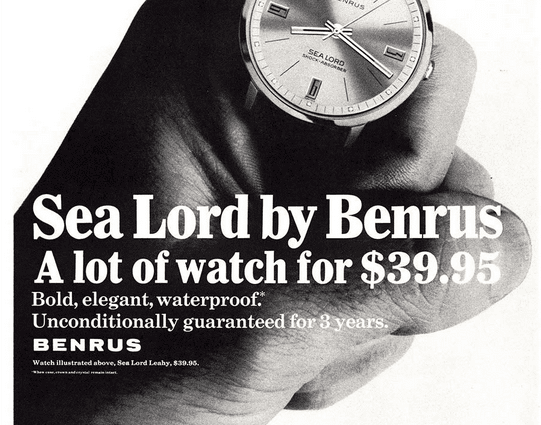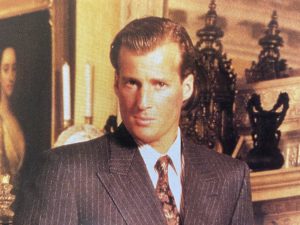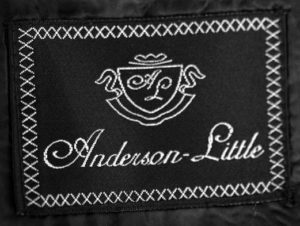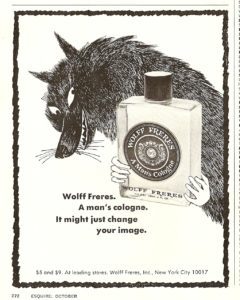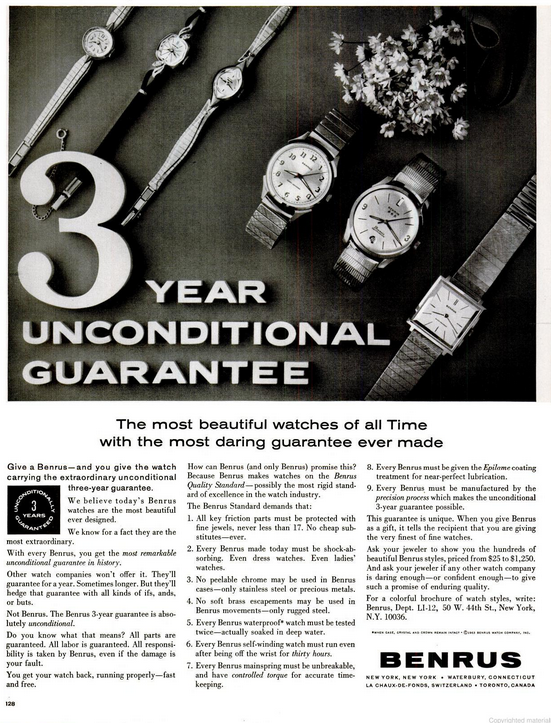 The historic U.S. watch brand Benrus has a new owner, and a new lease on life, after a failed revival by a Rhode Island entrepreneur. Investor Michael Sweeney, assisted by former Bulova exec Michael Goeller, is reviving the brand, which was founded in 1921.
The historic U.S. watch brand Benrus has a new owner, and a new lease on life, after a failed revival by a Rhode Island entrepreneur. Investor Michael Sweeney, assisted by former Bulova exec Michael Goeller, is reviving the brand, which was founded in 1921.
The current effort follows the unsuccessful revamping of the brand by Rhode Island’s Giovanni Feroce, according to the Providence Journal. The company under Feroce was in the news for a sponsorship deal with the Buffalo Bills that went sour for non-payment, and other issues. That being said, they did some interesting promotions, ones that helped put the brand in front of a new audience.
Began in 1921, Nearing Centennial
Originally, the brand was a mid-market U.S. watch, with advertising promoting its association with sports and the military. Both Babe Ruth and Charles Lindbergh, among many famous people, wore the watch, along with JFK. All its designs are classic, and reproductions would have a ready market, today, with the cachet of a Ray-Ban or Jeep. (A history of the brand is at thewatchguy.com.)
During World War II, the company shut down commercial watch production for the war effort. But after the end of the war, its manufacturing machines were worn, and no longer able to produce watches as before. When owner Benjamin Lazrus went to Switzerland to get parts for Benrus, he ended up agreeing with the Swiss to not only import from Switzerland, but to shut down his Waterbury, Conn. factory. Benrus would then restrict itself to cases and marketing.
The issue came to the attention of the Justice Department; they alleged that the Swiss industry had been illegally targeting the U.S. watch industry. It was a complicated case; the allegation was that the shut down was organized, between manufacturers and associations. Named in the suit were Foote, Cone and Belding, the ad firm, and makers including Rolex, Movado, Gruen, Bulova, Stern and Longines-Whittnauer. Companies such as Elgin, Waltham and Hamilton eventually turned into mere importers.
The Swiss Conspiracy
In the case, the Government alleged a conspiracy to impose unreasonable restraints on the form and domestic trade and commerce of the United States, in violation of Section 1 of the Sherman Act.
The case alleged a “broad combination and conspiracy allegedly engaged in since 1931 by Swiss and United States manufacturers and sellers of Swiss watches and watch parts and their trade associations to restrict, eliminate and discourage the manufacture of watches and watch parts in the United States and to restrain United states imports and exports of watches and watch parts for both manufacturing and repair purposes.”
The gist of the 1962 case is that the Swiss, after World War II, restricted and bought out American companies to systematically shut down the U.S. watch industry.
The case was decided by U.S. District Judge John M. Cashin (1892-1970), known for his anti-trust and anti-narcotics rulings. There are startling parallels to the shut down of entire industries in the United States today, from car-making to appliances to light bulbs. Reading the summary of the case, you can’t but help notice that the Justice Department no longer takes up these sort of Sherman cases to defend American companies and industry.
At bottom is the excerpt of the case referring to Benrus, from U.S. Trade Reform hearings in 1972. You can read exactly what happened to the U.S. watch industry, a case which might apply to many situations with U.S. industries today.
The Benrus brand could be a real success. But for brands that have good stories, but have been forgotten, it is a longer road for revival. There is no immediate brand awareness, and that backstory must be told, over and over again, until the brand is well known again. This is the case with brands like the Mini car, which was not known well in the U.S. when it was revived by BMW. Another example is the fashion brand Lilly Pulitzer, which had a hiatus, and then came back much larger than it was originally, on the strength of the idea of the brand. One can gain the audience back by mass advertising, or by the slow, word-of-mouth advertising that comes from a niche brand.
The revived company has some nice watches as part of the collection, including the $1395 Classic Watch, with a handsome blue face. Find out more at the Benrus website.

